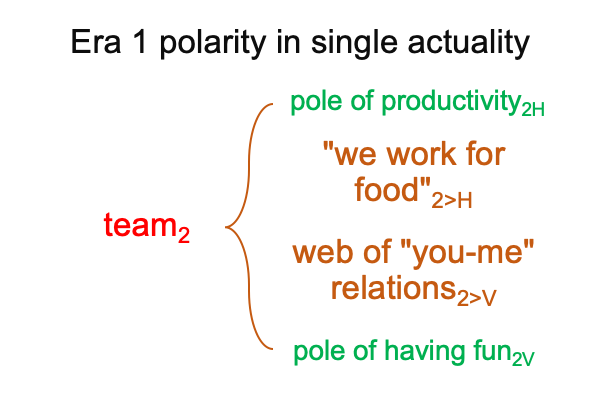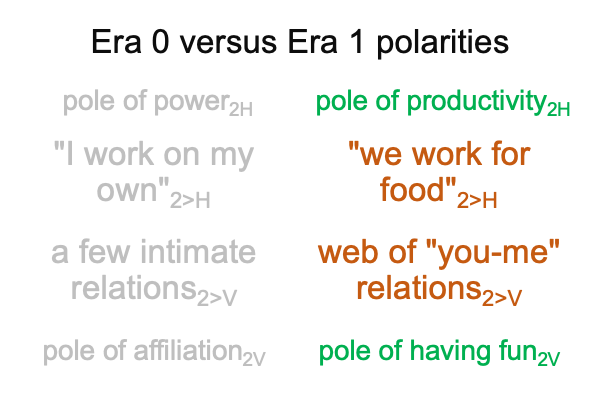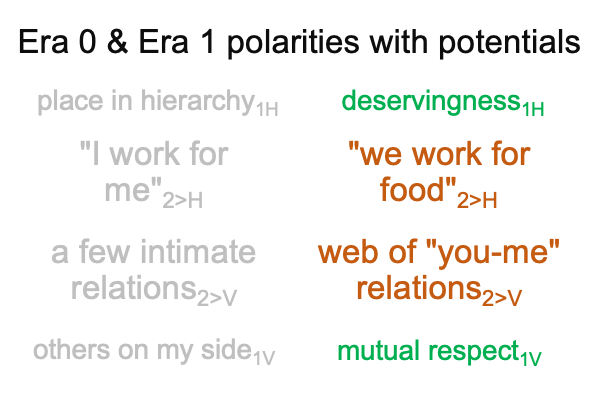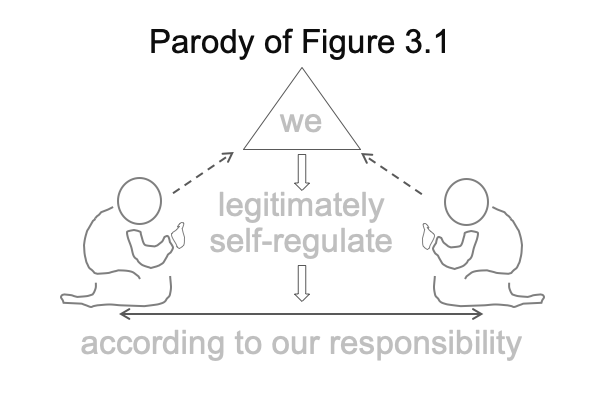0482 Tomasello chops a good deal of philosophical wood.
His labors are complicated by the fact that the word, “team2b“, is constituted by two actualities, productivity1H and having fun2V, causing the single term to polarize. The two poles are captured in two slogans, “we work for food” and “web of ‘you-me relations”.
Here is a picture of the polarization of the intersection of team2.

0483 In order to visualize the roots and the branches of Tomasello’s task, consider projecting the polarization of the teamback in time from the era of joint intentionality to the era of individual intentionality.
The results are remarkable.

0484 Tomasello’s woodpile is now starting to look like it is full of explicit abstractions that will demand further explicit abstractions that will demand further explicit abstractions.
Did Tomasello axe for this complicated mess?
0484 On top of that, if one substitutes the underlying potentials for the constituting actualities, within the paradigm of polarity, then the explicit abstractions that Tomasello chops in the first session transmogrify into a pile of philosophical wood ready for a second session.

It may take a second to figure out the two preceding diagrams.
Just saying.
0485 With the difficulties embedded within Tomasello’s woodpile now visualized, I turn to the subsection titled, “Second Person Agency”.
The initial challenge of the era of joint intentionality concerns good and fun collaborative partners choosing good and productive collaborative partners.
The axe comes down and this log splits into guilt (for when one denies mutual respect to others) and responsibility (for being productive). What about labels for when one provides others with mutual respect and when one is not so productive?
Uh-oh. Now, Tomasello has two more logs to chop.
0486 Adding to this philosophical woodpile, consider the question of how joint intentional activity arises in the first place.
Here, Tomasello offers a figure, depicting two cooperating individuals facing an elevated gray triangle, emblazoned with the words, “Joint commitment to role ideals”. To me, that means “we”. We encompass our joint commitment to well… whatever the team is supposed to do. From the bowels of the triangle, an arrow descends, bearing the words, “legitimately self-regulate”. The arrow terminates, hitting the ground (so to speak) with the words, “according to our responsibility”. Then, the impact of the arrow spreads to the feet of the cooperating individuals, and emerges from each head as an arrow returning to we, the embodiment of a joint commitment to role ideals.
0487 Here is my parody of Figure 3.1.

Hmmm. Tomasello’s stick figures have turned into meditative circle-heads.
0488 Why depict the individuals as circle-heads, weighed down by explicit abstractions that characterize “we”, “legitimate”, “self-regulate” and “responsibility”?
These spoken labels are not available to team members collaboratively foraging in the era of joint attention. What is there to picture or point to using hand-talk? Instead, whatever these spoken labels refer to are adaptations that end up as phenotypic traits, expressions of hominin neural and physiological architecture.
The meditative figures reflect the two minds of Tomasello. One is committed to the role ideal of evolutionary anthropologist. One is devoted to concocting explicit abstractions in accordance with that ideal. These two guide Tomasello’s philosophical axe in order to chop purely relational beings into label-worthy fragments.
0489 Towards the end of chapter three, concerning the era of joint intentionality, Tomasello launches into a subsectiontitled, “The Original Ought”.
What is moral psychology?
What is second-person morality?
The answer, of course, depends on how one defines these labels.
Or, does it?
